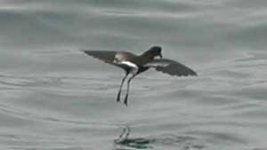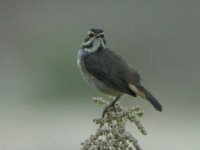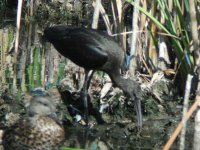marcbuzzard
Well-known member
South Western Algarve - Aug 2006
South Western Algarve – August 5th-19th, 2006
This year’s family summer holiday destination saw the four of us heading off to the village of Praia da Luz in the South Western corner of Portugal. It was to be a relaxing family holiday first and foremost with a few birding trips thrown in (especially early mornings). We landed at Faro airport, picked up or hire car and drove the hour or so to our villa. Praia da Luz is around 10km further west than the town of Lagos in the western end of the Algarve region of Portugal.
What a pleasant surprise when we arrived! A leafy garden with lovely views over the countryside and sea, I immediately knew that a lot of my birding could be done from the poolside. Perfect!
Over the next fortnight pool-side highlights included daily flocks of 50+ Azure-winged Magpies (I don’t think I’ve ever seen birds with such a character), Common Waxbills, Hoopoes, many Bee-Eaters, Spotless Starlings, Red-rumped Swallows, Melodious Warblers, Alpine Swifts, Pallid Swifts and a daily sighting of a fine Short-toed Eagle. From the upstairs veranda, Cory’s Sheawaters (and Common Dolphins) could be scoped each morning and evening and Blue Rock Thrushes could be seen on the nearby cliffs.
Highlight of the holiday for me was the pelagic trips; these were a birthday present from my wife. Aled (my son) and I booked ourselves onto a Shark fishing trip (an environmentally friendly one where all sharks were tagged and returned to the sea) and set off from the marina at Lagos sailing into the Atlantic for eight hours. Before the chum (the smelly bait put out to attract sharks) was put down I had already seen several very close Cory’s Shearwaters and a few Storm Petrels. It wasn’t long before I started seeing my target species – Wilson’s Petrel. As the chum’s slick started attracting birds, these little petrels started appearing from nowhere. At one time I counted an incredible 28 around the boat, some as close as 5 yards. It was an amazing feeling to think that these little birds are Southern Hemisphere birds and until recently a very rare bird in European waters. I had hoped to see a few, but could not believe that there was that many. Two Pomarine Skuas flew over head and a number of Sooty and Balearic Shearwaters went by. We also caught three amazing Blue Sharks which were lovely to see so close (this was the highlight for Aled!). A week later we repeated the trip and had a further 25+ Wilson’s Petrels, but this time also rewarded with two Caspian Terns and a very close Great Shearwater!
While staying at Luz, I made the nature reserve at Quinta da Rocha on the Alvor Estuary my local patch with several early morning and evening visits. The reserve centre is open to visitors on a Thursday morning and is well worth the visit then just for the home made Lemon cake!. 100+ Greater Flamingos were a wonderful sight there, while Black winged Stilts, Avocets, Kentish Plovers, 'Iberian' Yellow Wagtail, Green Sandpipers, Little Terns and Cattle Egrets were seen on every visit along with Woodchat Shrikes and Southern Grey Shrikes. One evening 2 Caspian Terns were amongst the Yellow legged Gull flock. Further down the coast were Pera marshes, to which I also visited a few times (it is conveniently situated behind a nice family beach!). Highlights here included many Purple Gallinules, 20+ Spoonbills, Purple Heron, Short toed Larks, 200+ Greater Flamingo and most of the species also seen at Quinta. In the Monchique Mountains, the mountain range that runs along the spine of the Algarve, I had great views of Rock Bunting, Cetti’s Warblers, Crested Lark, Short toed Eagles, many Southern Grey Shrikes and Cetti’s Warblers.
I had three target species while on holiday and I scored with two and a half. Black shouldered Kite is a bird I’ve always wanted to see and I was extremely lucky to see two. Both birds were found completely accidentally while driving. Luckily they have a habit of perching on telegraph poles so I managed to stop and watch them from my mobile hide. One bird was on the coast road between Odiexerre and Alvor, while the other was in the vicinity of Lagos zoo (around 20km north of Lagos). I was not really expecting to see this species, but on chatting to a local birder, he said many had been displaced by forest fires over recent years and more were being seen in the Algarve. The second target species was Great Spotted Cuckoo, a species apparently quite common in the area. I was lucky to find one fantastic juvenile bird behind Amodo beach on the western Portuguese coast; a superb area that is not at all over developed and must be very under watched I also came across Dartford Warbler, Thekla Larks and Corn Buntings in this part . The third bird I had hoped to see was Red necked Nightjar. A friend had given me some good site information and I spent several evenings trying to see this bird. Unfortunately the area was now fenced off, and what was frustrating was that I could hear their amazing call but only every now and then caught a shadow of something moving above the pines. Oh well, pehaps next time!
All in all I saw 102 species of bird during the fortnight and was thrilled with the quality of birds on offer in such accessible places. For a combined family / birders holiday it must be a near perfect destination. If anyone wants more information about birding in the area, places to stay or the area in general, I’d be happy to help.
Marc Hughes
One of the Wilson's Petrels taken with a hand held digi-camera off the back of the boat.
South Western Algarve – August 5th-19th, 2006
This year’s family summer holiday destination saw the four of us heading off to the village of Praia da Luz in the South Western corner of Portugal. It was to be a relaxing family holiday first and foremost with a few birding trips thrown in (especially early mornings). We landed at Faro airport, picked up or hire car and drove the hour or so to our villa. Praia da Luz is around 10km further west than the town of Lagos in the western end of the Algarve region of Portugal.
What a pleasant surprise when we arrived! A leafy garden with lovely views over the countryside and sea, I immediately knew that a lot of my birding could be done from the poolside. Perfect!
Over the next fortnight pool-side highlights included daily flocks of 50+ Azure-winged Magpies (I don’t think I’ve ever seen birds with such a character), Common Waxbills, Hoopoes, many Bee-Eaters, Spotless Starlings, Red-rumped Swallows, Melodious Warblers, Alpine Swifts, Pallid Swifts and a daily sighting of a fine Short-toed Eagle. From the upstairs veranda, Cory’s Sheawaters (and Common Dolphins) could be scoped each morning and evening and Blue Rock Thrushes could be seen on the nearby cliffs.
Highlight of the holiday for me was the pelagic trips; these were a birthday present from my wife. Aled (my son) and I booked ourselves onto a Shark fishing trip (an environmentally friendly one where all sharks were tagged and returned to the sea) and set off from the marina at Lagos sailing into the Atlantic for eight hours. Before the chum (the smelly bait put out to attract sharks) was put down I had already seen several very close Cory’s Shearwaters and a few Storm Petrels. It wasn’t long before I started seeing my target species – Wilson’s Petrel. As the chum’s slick started attracting birds, these little petrels started appearing from nowhere. At one time I counted an incredible 28 around the boat, some as close as 5 yards. It was an amazing feeling to think that these little birds are Southern Hemisphere birds and until recently a very rare bird in European waters. I had hoped to see a few, but could not believe that there was that many. Two Pomarine Skuas flew over head and a number of Sooty and Balearic Shearwaters went by. We also caught three amazing Blue Sharks which were lovely to see so close (this was the highlight for Aled!). A week later we repeated the trip and had a further 25+ Wilson’s Petrels, but this time also rewarded with two Caspian Terns and a very close Great Shearwater!
While staying at Luz, I made the nature reserve at Quinta da Rocha on the Alvor Estuary my local patch with several early morning and evening visits. The reserve centre is open to visitors on a Thursday morning and is well worth the visit then just for the home made Lemon cake!. 100+ Greater Flamingos were a wonderful sight there, while Black winged Stilts, Avocets, Kentish Plovers, 'Iberian' Yellow Wagtail, Green Sandpipers, Little Terns and Cattle Egrets were seen on every visit along with Woodchat Shrikes and Southern Grey Shrikes. One evening 2 Caspian Terns were amongst the Yellow legged Gull flock. Further down the coast were Pera marshes, to which I also visited a few times (it is conveniently situated behind a nice family beach!). Highlights here included many Purple Gallinules, 20+ Spoonbills, Purple Heron, Short toed Larks, 200+ Greater Flamingo and most of the species also seen at Quinta. In the Monchique Mountains, the mountain range that runs along the spine of the Algarve, I had great views of Rock Bunting, Cetti’s Warblers, Crested Lark, Short toed Eagles, many Southern Grey Shrikes and Cetti’s Warblers.
I had three target species while on holiday and I scored with two and a half. Black shouldered Kite is a bird I’ve always wanted to see and I was extremely lucky to see two. Both birds were found completely accidentally while driving. Luckily they have a habit of perching on telegraph poles so I managed to stop and watch them from my mobile hide. One bird was on the coast road between Odiexerre and Alvor, while the other was in the vicinity of Lagos zoo (around 20km north of Lagos). I was not really expecting to see this species, but on chatting to a local birder, he said many had been displaced by forest fires over recent years and more were being seen in the Algarve. The second target species was Great Spotted Cuckoo, a species apparently quite common in the area. I was lucky to find one fantastic juvenile bird behind Amodo beach on the western Portuguese coast; a superb area that is not at all over developed and must be very under watched I also came across Dartford Warbler, Thekla Larks and Corn Buntings in this part . The third bird I had hoped to see was Red necked Nightjar. A friend had given me some good site information and I spent several evenings trying to see this bird. Unfortunately the area was now fenced off, and what was frustrating was that I could hear their amazing call but only every now and then caught a shadow of something moving above the pines. Oh well, pehaps next time!
All in all I saw 102 species of bird during the fortnight and was thrilled with the quality of birds on offer in such accessible places. For a combined family / birders holiday it must be a near perfect destination. If anyone wants more information about birding in the area, places to stay or the area in general, I’d be happy to help.
Marc Hughes
One of the Wilson's Petrels taken with a hand held digi-camera off the back of the boat.
Attachments
Last edited:








